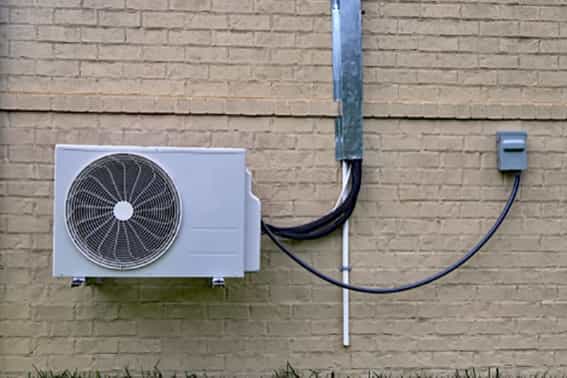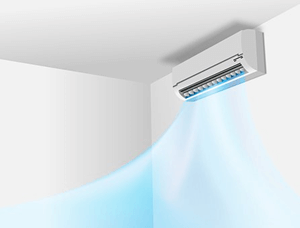What is a Mini-Split AC System: Are They Worth It?

Mini-Split systems are becoming more popular, but are they worth the money? Learn how they work and get the info you need on these small AC units to make the decision yourself.


Mini-Split systems are becoming more popular, but are they worth the money? Learn how they work and get the info you need on these small AC units to make the decision yourself.
Mini-splits, also known as ductless air conditioning units, are gaining popularity thanks to their energy efficiency and potential to create a range of temperature zones within the same home. While they can get expensive, they’re easy to retrofit into homes without HVAC ductwork. But is a mini-split the best AC unit for your home?
If you’re trying to choose between a mini-split AC system and a traditional HVAC system, you need to know what a mini-split system is and how it works. For some homeowners, a mini-split AC system can be the better choice – it can allow you to downsize while remaining in your home, for example, or keep family members from fighting over the thermostat. Here’s what you need to know.
How Does a Mini-Split AC System Work?
In a traditional HVAC system, a unit outside your home cools air and distributes it through your home via your ductwork. However, a mini-split system does not rely on ductwork to supply your home with cold air. Instead, refrigerant moves through insulated lines from the outdoor unit to indoor units located in each of your home’s cooling zones. Some outdoor units are powerful enough to divide your home into as many as nine cooling zones, each cooled by its own separate unit. Each indoor unit cools the room or zone it’s in.
These wall AC units are more secure than window AC units because they require only a small hole to be drilled into the wall to run the refrigerant lines through, so there’s no need to cut a huge hole in the wall and there’s no possibility that a burglar could just yank the unit out of the window and crawl inside. But mini-splits can be more expensive than traditional HVAC systems – a single-zone system can start at about $3,000, while a four-zone system can cost at least $12,000. The more zones you want, the higher the cost.

Thinking about coverage?
Security for your home. Protection for your budget.
Pros and Cons of Mini-Split AC Units
Mini-split AC units don’t require ductwork, which makes them a good option for installation in homes that don’t have ductwork, because adding ducts can significantly increase the cost of installing a traditional HVAC. Mini-splits are also good for installing climate control in additions or mother-in-law units.
These aren’t the only benefits of a mini-split AC though. Mini-splits are about 25 to 30 percent more efficient than traditional AC systems because nothing is lost to the ductwork itself. Mini-splits also have inverter-driven compressors, which don’t turn on and off constantly. Instead, they speed up or slow down based on system requirements. This makes them even more efficient than a traditional AC system, which loses a lot of energy in starting up a compressor repeatedly.
Mini-splits are popular with homeowners who want more precise control over the temperature of individual rooms in their homes. Each unit can be individually adjusted, so you’ll be able to call a truce in the Thermostat Wars – at least until winter. If you have rooms in your home that you aren’t using, one or two mini-split wall units can help you cool the rooms you are using, while keeping the whole-house thermostat at a higher temperature. This prevents mold and other problems that can arise from merely closing the vents in unused rooms.
The drawbacks of mini-splits include their installation price, which can be higher than traditional HVAC systems. You also might not love the look of a wall AC unit in every room, either, although there are floor and recessed ceiling models, too. Mini-splits also require more maintenance. You’ll need to clean the filter every month, and more often if you have pets – the fans in mini-splits can’t handle dirty filters, so falling behind on monthly maintenance can shorten the life of your unit. You’ll still need to have an annual AC tune-up from a professional technician, who will check your unit’s refrigerant pressure and flush the condensate lines, among other things.
Choosing the Best HVAC System for Your Needs
If you already have a traditional HVAC system, it may be cheaper to just go ahead and get another one. But if you’re installing AC in a home that doesn’t have ducts, or you’re looking for a small air conditioner to cool a specific room or rooms, a mini-split system may be the best choice. It can give you more precise temperature control and reduce your energy bills, although it may not pay for itself.
Speaking of the AC, did you know that the parts and components of your mini-split AC system are covered by an American Home Shield® Home Warranty? A home warranty can help reduce repair costs for the systems and appliances you rely on every day and save you time because we'll assign a trusted, qualified Pro to repair your covered item. Take a look at our home warranty plans to find the best fit for your home and needs.
Explore how our home warranty plans can help keep your A/C in working order all season long.

AHS assumes no responsibility, and specifically disclaims all liability, for your use of any and all information contained herein.
Have a plan for your home when things don't go according to plan
Shop Home WarrantiesDevelopment